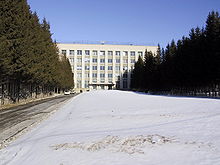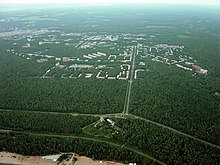Akademgorodok



Akademgorodok (Russian: Академгородо́к, IPA: [ɐkəˌdʲemɡərɐˈdok], "Academic Town" or "Academic City") is a part of the Sovetsky District of the city of Novosibirsk, Russia, located 30 km south of the city center and about 10 km west of the Science town Koltsovo. It is the educational and scientific centre of Siberia.
It is surrounded by a birch and pine forest on the shore of the Ob Sea, an artificial reservoir on the river Ob. Formally it is a part of Novosibirsk city, and has never been a closed city.
Located within Akademgorodok is Novosibirsk State University, 35 research institutes, a medical academy, apartment buildings and houses, and a variety of community amenities including stores, hotels, hospitals, restaurants and cafes, cinemas, clubs and libraries. The House of Scientists (Dom Uchyonykh), a social center of Akademgorodok, hosts a library containing 100,000 volumes – Russian classics, modern literature and also many American, British, French, German, Polish books and magazines. The House of Scientists also includes a picture gallery, lecture halls and a concert hall.
History


The town was founded in 1957 under the auspices of the Academy of Sciences of the USSR. Academician Mikhail Alexeyevich Lavrentyev, a mechanician and mathematician, the first Chairman of the Siberian Branch of the Soviet Academy of Sciences, played a prominent role in establishing Akademgorodok. At its peak, Akademgorodok was home to 65,000 scientists and their families, and was a privileged area to live in.[1]
During the Soviet period (1961–1991), due to the peculiarity of the Soviet economic system, monetary rewards did not always translate into a higher standard of living. To offset this, a special compensation system was devised in Akademgorodok for its residents and leading scientists. For example, residents of Akademgorodok had access to special food ration distribution outlets (stoly zakazov) that provided, most of the time, an access to some basic subsidized foodstuffs, which were not always easily obtainable elsewhere. Scientists who had obtained a doctorate (a post-Ph.D. degree under the Russian system) were rewarded by the authorities with the special food delivery service (doktorskiy zakaz), which provided access to a wider selection of groceries than available to the general population; some of the scientists, despite being eligible, refused it on moral grounds.[citation needed] Full and corresponding members of the Academy of Sciences had access to still higher level of service (akademicheskiy zakaz) and were eligible to live in single-family residences (called "cottages"), considered luxurious by Soviet standards, as most of the population lived in apartments in nine- and four-story multi-apartment buildings.
During the early years residents enjoyed great freedom from the rules and restraints of the Soviet Union, with a modernist cultural centre exhibiting works by banned Soviet artists, risqué poetry evenings, and other activities allowed nowhere else. Scientific research in areas dismissed as dangerous pseudoscience in Moscow, such as cybernetics and genetics, flourished. However, freedoms were severely curtailed in the 1970s during the Brezhnev era.[1]
Akademgorodok in the post-Soviet era
The collapse of the Soviet Union saw many scientists, including whole cadres of Russia's top minds in the physical and theoretical sciences, reduced to penury. Beginning in the mid-1990s, as economic reforms allowed private investment in Russia, Akademgorodok saw the beginnings of venture funding. In 1992, a software company called Novosoft was founded here, and its chief client was IBM. Around this time CFT started, which specializes in banking and financial software. By 1997 private investment reached US$10 million; by 2006 it was $150 million, reaching about $1 billion by 2015.[1] Intel and Schlumberger have brought work to Akademgorodok, and other companies are following them into the area. Many scientists. including Lavrentyev's son, also named Mikhail and also an accomplished mathematician in his own right, were deeply involved in this renaissance. Currently its population stands at over 100,000 and there are over 40 research institutes located within Akademgorodok. While still minuscule by the standards of other countries, the private venture effort in Akademgorodok has breathed new life into what was once one of the Soviet Union's premier scientific centers.[2]
As of 2015[update], 300 companies had been set up since 2011, employing about 9,000 people and generating 17bn roubles (£175M) annually.[1]
The area is sometimes called "Silicon Forest".[3][4] A much larger technology center in the former Soviet Union is the Skolkovo Innovation Center, conveniently located on the outskirts of Moscow, a $4bn state project with annual revenues of $1bn.[1]
List of research and education facilities in Akademgorodok
- Kutateladze Institute of Thermal Physics
- Nikolaev Institute of Inorganic Chemistry
- Boreskov Institute of Catalysis
- Vorozhtsov Institute of Organic chemistry
- Budker Institute of Nuclear Physics
- Ershov Institute of Informatics Systems
- Institute of Informatics and Mathematical Geophysics
- Institute of Chemical Biology and Fundamental Medicine
- Institute of Cytology and Genetics[5]
- Institute of Molecular and Cellular Biology
- Sobolev Institute of Mathematics
- United Institute of Geology, Geophysics and Mineralogy
- Institute of Automation and Electrometry
- Institute of Semiconductors Physics
- Institute of Theoretical and Applied Mechanics
- Institute of Chemical Kinetics and Combustion
- Lavrentyev Institute of Hydrodynamics
- Institute of History of Siberian Branch of the Russian Academy of Sciences[1]
- Institute of Philology
- Institute of Philosophy and Law
- Institute of Laser Physics
- Central Siberian Botanical Garden
- Institute of Solid State Chemistry and Mechanochemistry
- Research Institute of Circulation Pathology
- Institute of Economics and Industrial Engineering
- Presidium of the Siberian Division of the Russian Academy of Sciences
- House of Scientists (in Russian)
- Novosibirsk State University (Official site in English, in Russian)
- Specialized Educational Scientific Center on Physics, Mathematics, Chemistry and Biology of Novosibirsk State University
- Museum of Archæology and Ethnography
- Central Siberian Geological Museum
- Institute of Computational Technologies
The Quality Schools International QSI International School of Novosibirsk, previously located in Akademgorodok, opened in 2008.[6]
Sightseeing
The Technopark (Academpark) has a distinctive headquarters, constructed in 2013. It has two inclined towers connected by an overhead passage on the 13-14th floor level. Its unique form is the source of its nickname: "the geese".[7]
See also
References
- ^ a b c d e Oliver Wainwright (5 January 2016). "Step into Silicon Forest, Putin's secret weapon in the global tech race". The Guardian. Retrieved 5 January 2016.
- ^ Fortune April 2, 2007.
- ^ Russia’s Siberian High-Tech Haven, Wall Street Journal blog, March 19, 2007
- ^ Tech in a very cold place: A former Soviet science center is a hotbed of software innovation., Fortune Magazine, by Brett Forrest, March 23, 2007
- ^ Institute of Cytology and Genetics
- ^ "Home." QSI International School of Novosibirsk. October 2, 2009. Retrieved on May 15, 2016.
- ^ b-id.ru, Битриксоид. "Welcome - Academpark". www.academpark.com. Retrieved 2017-02-05.
External links
- Akademgorodok on the Internet (in Russian and English)
- Official website of the Siberian Division of the Russian Academy of Sciences (in Russian and English)
- Akademgorodok on NovosibirskGuide.com
- Photographs of Akademgorodok (in Russian)
- Silicon Forest: Magnum presents the center of Russia's science industry: photographs of Akademgorodok
- Academ.org one of local area networks of Academgorodok - forum, photos
- Josephson, Paul R. (1997) New Atlantis Revisited: Akademgorodok, the Siberian City of Science. Princeton, New Jersey: Princeton University Press. ISBN 9780691044545.
- Dispatches - Silicon Siberia Fortune April 2, 2007 pp 33–36
